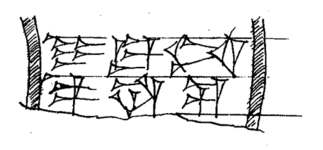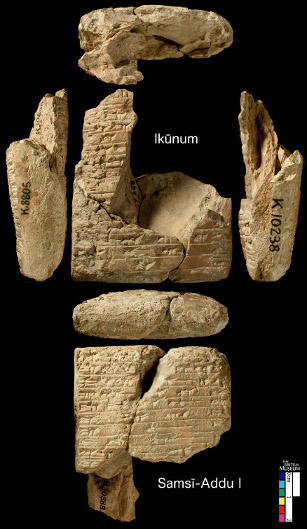Ikūnum
According to the Assyrian King List [/riao/KingLists/AssyrianKingList/index.html] (AKL), Ikūnum was the thirty-fourth ruler of Aššur. The AKL does not preserve the length of his reign, but, according to the Kültepe Eponyms List (KEL), he ruled for either fourteen or fifteen years (Veenhof 2003, 6 and 42). Ikūnum succeeded his father Erišum I and was followed on the throne by his son Sargon I. He is known from five contemporary royal inscriptions, all of which were found at Aššur, and one Neo Assyrian copy from Nineveh (text no. 5. One of these (text no. 2) mentions another son of Ikūnum by name: Aššur-imittī. That inscription states that this son brought a stone chest into the Aššur temple. Veenhof (2003, 43) suggests that Aššur-imittī may have carried out this task because Ikūnum had already died, and, thus, regards this as possible evidence that Ikūnum died early. A later Old Assyrian king, Aššur-rēm-nišēšu, mentions Ikūnum in a royal inscription (text no. 1 [/riao/ria1/Q005708/]) as a previous builder of one of Aššur's city walls.
Like his predecessors and successors, Ikūnum was personally involved in Assyrian trade in Anatolia; this is clear from archival records found at the Assyrian kārum at Kaneš (Veenhof 2003, 42). In addition to Sargon I's references to his father's commercial activities in two letters (KTS 30 and POAT 18 [http://www.hethport.uni-wuerzburg.de/altass/]), Ikūnum is cited in several administrative documents (Veenhof 2003, 42).
Bibliography
Browse the RIA 1 Corpus [/riao/ria1/pager/]
Jump to Ikūnum 1 Ikūnum 2 Ikūnum 3 Ikūnum 4 Ikūnum 5
Several inscribed bricks found at Aššur record that Erišum I's successor Ikūnum sponsored construction on the Adad temple in that city.
Access the composite text [/riao/ria1/Q005639/] of Ikunum 1.
Sources
| (1) VA Ass 03207a (Ass 05266) | (2) Ist EȘEM 06622 (Ass 03441) |
| (3) VA Ass 03206b (Ass 04298) | (4) VA Ass 03206a (Ass 03999) |
| (5) VA Ass 03207b | (6) VA Ass 03207c |
Bibliography
- 1905 Andrae, MDOG 28 p. 11 (ex. 1, provenance)
- 1926 Meissner, IAK VI 1 (exs. 1-4, edition)
- 1927 Luckenbill, ARAB 2 p. 502 (translation)
- 1972 Grayson, ARI 1 XXXIV 1 (translation)
- 1976 Larsen, City-State p. 60 n. 47 (study)
- 1984 Marzahn and Rost, Ziegeln 1 nos. 73-77 (exs. 1, 3-6, study)
- 1985 Rost and Marzahn, VAS 23 nos. 22-26 (exs. 1, 3-6, copy)
- 1987 Grayson, RIMA 1 p. 41-42 A.0.34.1 (edition)
A piece of a hard white stone (or porcelain?) chest discovered in the
Aššur temple at Aššur is inscribed with a twelve-line text of
Ikūnum. It states that this Assyrian ruler had the object made and
dedicated to his tutelary deity. Aššur-imittī, Ikūnum's son, is said
to have brought the chest into Aššur's temple. The object is now in
the Vorderasiatisches Museum (Berlin).
An interesting feature of this inscription is that its text reads from
bottom to top, i.e. line 1 is at the bottom and line 12 is at the top.
Access the composite text [/riao/ria1/Q005640/] of Ikunum 2.
Source
Bibliography
- 1926 Meissner, IAK VI 2 (edition)
- 1927 Luckenbill, ARAB 2 p. 502 (translation)
- 1935 Gelb, Alishar p. 22 (study)
- 1955 Haller, Heiligtümer p. 47 (provenance)
- 1961 Borger, EAK 1 p. 6 (study)
- 1962 Meyer, Jahrtausende p. 182 (translation)
- 1972 Grayson, ARI 1 XXXIV 2 (translation)
- 1987 Grayson, RIMA 1 p. 42-43 A.0.34.2 (edition)
A stone fragment from Aššur preserves part of the beginning of an inscription of Ikūnum. It is too badly damaged to determine which accomplishment it originally commemorated. The present whereabouts of this object is unknown.
Access the composite text [/riao/ria1/Q005641/] of Ikunum 3.
Source
Bibliography
- 1926 Meissner, IAK VI 3 (edition)
- 1972 Grayson, ARI 1 XXXIV 3 (translation)
- 1987 Grayson, RIMA 1 p. 43 A.0.34.3 (edition)
A potsherd from Aššur and now in Berlin (Vorderasiatisches Museum) is inscribed with the first two lines of a text of Ikūnum.

VA Ass 02267. Copy from Schroeder, KAH 2 no. 13.
Access the composite text [/riao/ria1/Q005642/] of Ikunum 4.
Source
Bibliography
- 1922 Schroeder, KAH 2 no. 13 (copy)
- 1926 Meissner, IAK VI 4 (edition)
- 1926 Luckenbill, ARAB 1 §39 (translation)
- 1972 Grayson, ARI 1 XXXIV 4 (translation)
- 1987 Grayson, RIMA 1 p. 44 A.0.34.4 (edition)
A Neo-Assyrian tablet from Nineveh, possibly a school text, contains two different royal inscriptions. The better-preserved obverse contains a text of Samsī-Addu I, while the damaged reverse is inscribed with a text of Ikūnum. A.K. Grayson (RIMA 1) thought that the second inscription belonged to Samsī-Addu I and edited it as part of Samsī-Addu I 3, but H.D. Galter has recently and convincingly shown that the text on the reverse is in fact an inscription of Ikūnum, which he identified on the basis of text no. 3. The edition presented here is based on collation of the tablet from the photograph posted on the CDLI.

K 08805 + K 10238 + K 10888. © The Trustees of the British Museum.
Source
Bibliography
Jamie Novotny, Poppy Tushingham & Nathan Morello
Jamie Novotny, Poppy Tushingham & Nathan Morello, 'Ikūnum', RIA 1: Inscriptions from the Origins of Assyria to Arik-dīn-ili, The RIA Project, 2024 [http://oracc.org/EarlyBeginnings/Puzur-AshurDynasty/Ikunum/]